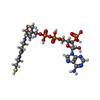+Search query
-Structure paper
| Title | Analysis of the mechanosensor channel functionality of TACAN. |
|---|---|
| Journal, issue, pages | Elife, Vol. 10, Year 2021 |
| Publish date | Aug 10, 2021 |
 Authors Authors | Yiming Niu / Xiao Tao / George Vaisey / Paul Dominic B Olinares / Hanan Alwaseem / Brian T Chait / Roderick MacKinnon /  |
| PubMed Abstract | Mechanosensitive ion channels mediate transmembrane ion currents activated by mechanical forces. A mechanosensitive ion channel called TACAN was recently reported. We began to study TACAN with the ...Mechanosensitive ion channels mediate transmembrane ion currents activated by mechanical forces. A mechanosensitive ion channel called TACAN was recently reported. We began to study TACAN with the intent to understand how it senses mechanical forces and functions as an ion channel. Using cellular patch-recording methods, we failed to identify mechanosensitive ion channel activity. Using membrane reconstitution methods, we found that TACAN, at high protein concentrations, produces heterogeneous conduction levels that are not mechanosensitive and are most consistent with disruptions of the lipid bilayer. We determined the structure of TACAN using single-particle cryo-electron microscopy and observed that it is a symmetrical dimeric transmembrane protein. Each protomer contains an intracellular-facing cleft with a coenzyme A cofactor, confirmed by mass spectrometry. The TACAN protomer is related in three-dimensional structure to a fatty acid elongase, ELOVL7. Whilst its physiological function remains unclear, we anticipate that TACAN is not a mechanosensitive ion channel. |
 External links External links |  Elife / Elife /  PubMed:34374644 / PubMed:34374644 /  PubMed Central PubMed Central |
| Methods | EM (single particle) |
| Resolution | 2.8 - 3.5 Å |
| Structure data | EMDB-24107, PDB-7n0k: EMDB-24108, PDB-7n0l: |
| Chemicals |  ChemComp-COA: |
| Source |
|
 Keywords Keywords | MEMBRANE PROTEIN / lipid metabolism / coenzyme A |
 Movie
Movie Controller
Controller Structure viewers
Structure viewers About Yorodumi Papers
About Yorodumi Papers








